Quatermass and the Pit (film)
7.6 /10 1 Votes
80% Rotten Tomatoes Genre Sci-Fi, Horror Duration Language English | 7.2/10 IMDb Country United Kingdom | |||||||||||||||||||||||||||||||||
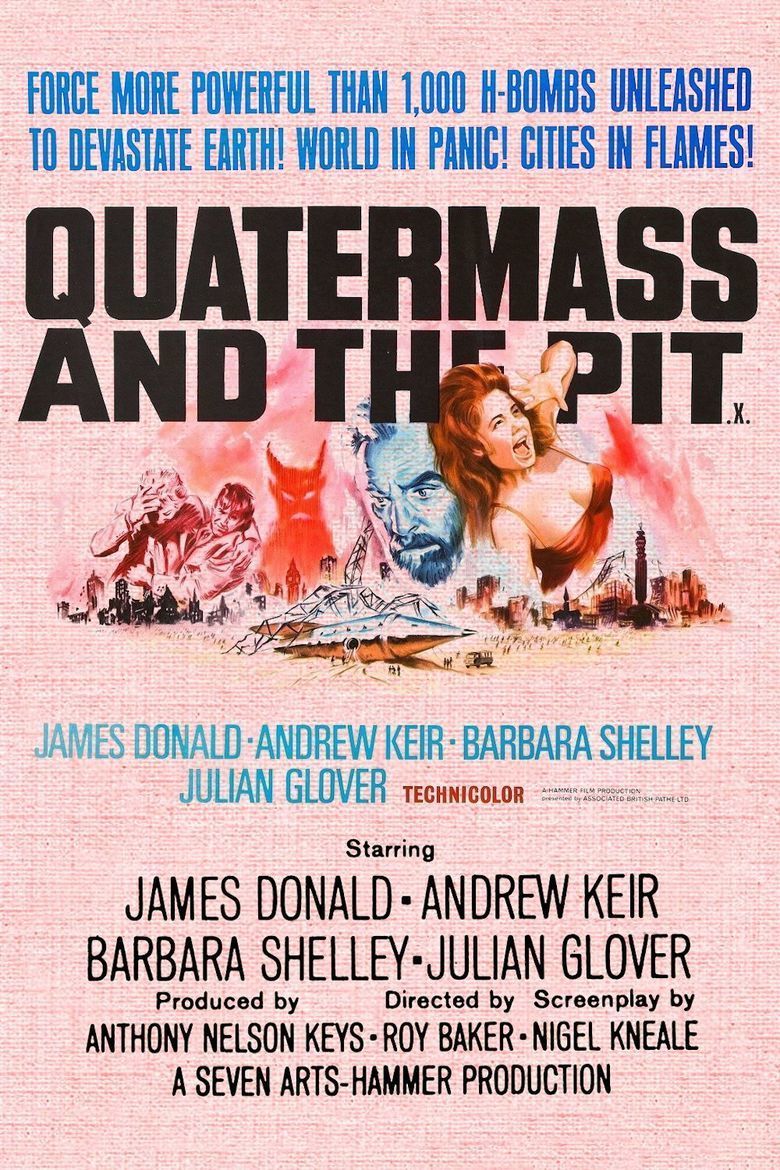 | ||||||||||||||||||||||||||||||||||
Release date 9 November 1967 (1967-11-09) Film series The Quatermass Xperiment Film Series Cast (Dr. Mathew Roney), (Prof. Bernard Quatermass), (Barbara Judd), (Colonel Breen), Duncan Lamont (Sladden), Bryan Marshall (Captain Potter)Similar movies Guardians of the Galaxy , Independence Day , Home , It! The Terror from Beyond Space , Jurassic Park , Cowboys & Aliens Tagline World in panic! Cities in flames! | ||||||||||||||||||||||||||||||||||
Five million yearsto earth quatermass and the pit 1967 film discovery of pentagon in space ship
Quatermass and the Pit (a.k.a. Five Million Years to Earth in the United States) is a 1967 British science fiction horror film from Hammer Film Productions, a sequel to the earlier Hammer films The Quatermass Xperiment and Quatermass 2. Like its predecessors, it is based on a BBC Television serial Quatermass and the Pit, written by Nigel Kneale. It was directed by Roy Ward Baker and stars Andrew Keir in the title role as Professor Bernard Quatermass, replacing Brian Donlevy who played the role in the two earlier films. James Donald, Barbara Shelley and Julian Glover appear in co-starring roles.
Contents
- Five million yearsto earth quatermass and the pit 1967 film discovery of pentagon in space ship
- Plot
- Origins
- Writing
- Casting
- Filming
- Music
- Title sequence
- Reception
- Legacy
- Home media release
- References

The storyline, which is largely faithful to the original television production, centres on the discovery of a mysterious object buried at the site of an extension to the London Underground. Also uncovered nearby are the remains of early human ancestors more than five million years old. Realising that the object is in fact an ancient Martian spacecraft, Quatermass deduces that the aliens have influenced human evolution and the development of human intelligence. The spacecraft has an intelligence of its own, and once uncovered begins to exert a malign influence, resurrecting Martian memories and instincts buried deep within the human psyche.
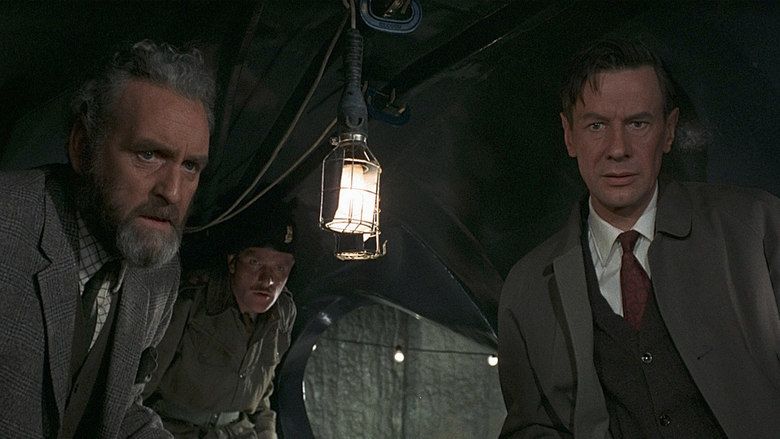
Nigel Kneale wrote the first draft of the screenplay in 1961, but difficulties in attracting interest from American co-financiers meant the film did not go into production until 1967. The director, Roy Ward Baker, was chosen because of his experience with technically demanding productions such as A Night to Remember; this was the first of six films that he directed for Hammer. Andrew Keir, playing Quatermass, found making the film an unhappy experience, believing Baker had wanted Kenneth More to play the role. Owing to a lack of space, the film was shot at the MGM studios in Elstree, Borehamwood rather than Hammer's usual home at the time, which was the Associated British Studios, also in Elstree.
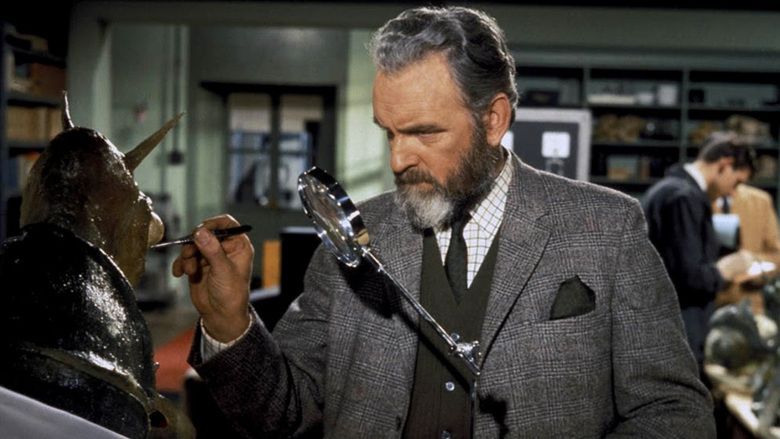
The film opened in November 1967 to favourable reviews and remains generally well regarded.
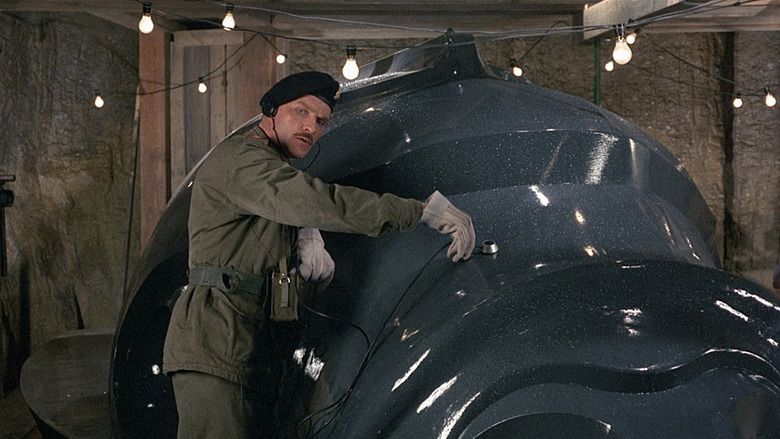
Plot
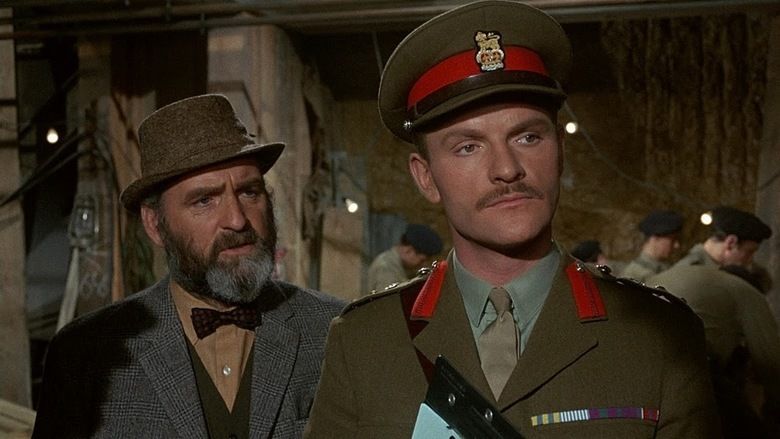
Workers building an extension to the London Underground at Hobbs End dig up skeletal remains. Palaeontologist Dr Matthew Roney (James Donald) is called in and deduces that they are the remnants of a group of five-million-year-old apemen, more ancient than any previous finds. One of Roney's assistants uncovers part of a metallic object. Believing it to be an unexploded bomb, they call in an army bomb disposal team.
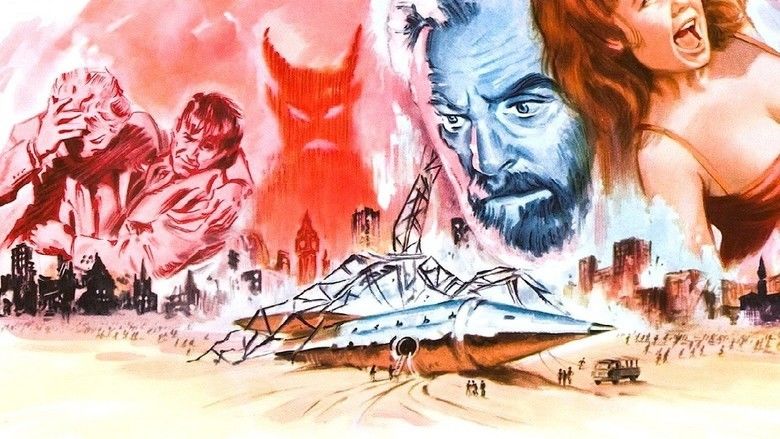
Meanwhile, Professor Bernard Quatermass (Andrew Keir) is dismayed to learn that his plans for the colonisation of the Moon are to be taken over by the military. He gives a cold reception to Colonel Breen (Julian Glover), who has been assigned to join Quatermass's British Experimental Rocket Group. When the bomb disposal team call for Breen's assistance, Quatermass accompanies him to the site. Breen concludes it is a V-weapon, but Quatermass disagrees. When another skeleton is found in an inner chamber, Quatermass and Roney realise that the object must also be five million years old. Quatermass suspects it is of alien origin, but Roney is certain the apemen are terrestrial.
Quatermass becomes intrigued by the name of the area, recalling that "Hob" is an old name for the Devil. Working with Roney's assistant, Barbara Judd (Barbara Shelley), Quatermass finds historical accounts of hauntings and other spectral appearances going back many centuries. They deduce that these events coincided with disturbances of the ground around Hobbs End.
An attempt to open a sealed chamber using a Borazon drill fails to make progress. However, a few moments after the drill is stopped, a small hole is seen, though the drill operator, Sladden (Duncan Lamont), is certain it was not created by his machine. The hole widens to reveal the corpses of three-legged, insectoid creatures with horned heads. Roney and Judd work to preserve the bodies before they decay. An examination of the creatures' physiology suggests they came from the planet Mars. Quatermass and Roney note the similarity between the appearance of the creatures and images of the Devil.
Sladden is overcome by a powerful telekinetic force emanating from the alien craft and flees to the sanctuary of a church. Sladden tells Quatermass he saw a vision of hordes of the alien creatures. Quatermass believes this is a race memory. Seeking proof, he returns to Hobbs End, bringing a machine Roney has been working on which taps into the primeval psyche. While trying to replicate the circumstances under which Sladden was affected, he notices that Judd has fallen under its influence. Using Roney's machine, he is able to record her thoughts.
Quatermass presents his theory to a government minister (Edwin Richfield) and other officials. The occupants of the spacecraft came from the dying Mars. Unable to survive on Earth, they chose to preserve some part of their race by creating a colony by proxy by significantly enhancing the intelligence of the primitive homo sapiens. The descendants of these apemen evolved into modern humans, but retain the vestiges of the Martian influence buried in their subconscious. He plays the recording of Judd's mind as evidence: it shows hordes of Martians engaged in what he interprets as a racial purge, cleansing the Martian hives of weaker members of their race. A disbelieving Breen offers an alternative theory: the 'alien craft' is a Nazi propaganda exercise designed to sow fear of an alien invasion among the populace. The minister rejects Quatermass's theory in favour of Breen's and decides to unveil the missile to the press.
Disaster strikes at the press event. The craft apparently draws power from the broadcasting equipment, and its influence is magnified. The streets of London erupt into violence as those affected go on a rampage. Breen becomes drawn towards the craft and is killed. Quatermass falls under the alien control as well, but is snapped out of it by Roney, who is unaffected. The two men realise that a small portion of the population are immune. The psychic energy becomes stronger, ripping up streets and buildings, and the spectral image of a Martian towers above the city, centred on Hobbs End. Recalling stories about how the Devil could be defeated with iron and water, Roney theorises the Martian energy could be discharged into the earth. Roney climbs to the top of a building crane and swings it into the spectre. The crane bursts into flames as it discharges the energy, killing Roney, but the image disappears.
Origins
Professor Bernard Quatermass was first introduced to audiences in two BBC television serials, The Quatermass Experiment (1953) and Quatermass II (1955), written by Nigel Kneale. The rights to both these serials were acquired by Hammer Film Productions, and the film adaptations – The Quatermass Xperiment and Quatermass 2, both directed by Val Guest and starring Brian Donlevy as Quatermass – were released in 1955 and 1957 respectively. Kneale went on to write a third Quatermass serial – Quatermass and the Pit – for the BBC, which was broadcast in December 1958 and January 1959. Hammer were once again interested in making a film adaptation, and Kneale, who had by then left the BBC and was working as a freelance screenwriter, completed a script in 1961. It was intended that Val Guest would once again direct and Brian Donlevy would reprise the role of Quatermass, with production to commence in 1963. However, securing finance for the new Quatermass film proved problematic. In 1957 Hammer had struck a deal with Columbia Pictures to distribute their pictures, and the two companies would go on to collaborate on thirty films between 1957 and 1964. Columbia, who were not interested in Quatermass, passed on the script and production went into limbo for several years. In 1964 Kneale and Anthony Hinds submitted a revised, lower-budget script to Columbia; but by this time the relationship between Hammer and Columbia had begun to sour, and the script was once again rejected. In 1966 Hammer entered into a new distribution deal with Seven Arts, ABPC and Twentieth Century Fox, and Quatermass and the Pit finally entered production.
Writing
The script of Quatermass and the Pit is largely faithful to the television original. The plot was heavily condensed to fit the shorter running time of the film, with the main casualty being the removal of a subplot involving the journalist James Fullalove, who does not appear in the film adaptation at all. The climax was altered slightly to make it more cinematic, with Roney using a crane to short out the Martian influence, whereas in the television version he merely throws a metal chain into the pit. The setting for the pit itself was changed from a building site to the London Underground. The closing scene of the television version, in which Quatermass pleads with humanity to prevent Earth's becoming the "second dead planet", was also dropped, in favour of a shot of Quatermass and Judd sitting alone amid the devastation wrought by the Martian spacecraft. The script was sent to John Trevelyan of the British Board of Film Censors in December 1966. Trevelyan replied that the film would require an 'X'-Certificate and raised concerns regarding the sound of the vibrations from the alien ship, the scenes of the Martian massacre, the scenes of destruction and panic as the Martian influence takes hold and the image of the Devil.
Casting
Other actors appearing in the film include Bryan Marshall, Peter Copley, Edwin Richfield (who previously appeared in Quatermass 2), Grant Taylor, and Robert Morris. Duncan Lamont, playing Sladden, had appeared in the original BBC production of The Quatermass Experiment in the key role of the hapless astronaut Victor Carroon. Quatermass and the Pit also features an early film role for Sheila Steafel who makes a brief appearance as a journalist near the start of the movie.
Filming
By the time Quatermass and the Pit finally entered production Val Guest was occupied on Casino Royale (1967), so directing duties went instead to Roy Ward Baker. Baker's first film had been The October Man (1947) and he was best known for The One That Got Away (1957) and A Night to Remember (1958). Following the failure of Two Left Feet (1963), he moved into television, directing episodes of The Human Jungle (1963–64), The Saint (1962–69) and The Avengers. Producer Anthony Nelson Keys chose Baker as director because he felt his experience on such films as A Night to Remember gave him the technical expertise to handle the film's significant special effects requirements. Baker, for his part, felt that his background on fact-based dramas such as A Night to Remember and The One That Got Away enabled him to give Quatermass and the Pit the air of realism it needed to be convincing to audiences. He was impressed by Nigel Kneale's screenplay, feeling the script was "taut, exciting and an intriguing story with excellent narrative drive. It needed no work at all. All one had to do was cast it and shoot it." He was also impressed with Hammer Films’ lean set-up: having been used to working for major studios with thousands of full-time employees, he was surprised to find that Hammer's core operation consisted of just five people and enjoyed how this made the decision making process fast and simple. Quatermass and the Pit was the first film the director was credited as “Roy Ward Baker”, having previously been credited as “Roy Baker”. The change was made to avoid confusion with another Roy Baker who was a sound editor. Baker later regretted making the change as many people assumed he was a new director.
Filming took place between 27 February and 25 April 1967. The budget was £275,000. At this time, Hammer was operating out of the Associated British Studios in Elstree, Borehamwood. However, a lack of space meant that production was relocated to the nearby MGM Borehamwood studio. There were no other productions working at the MGM Studios at this time so the Quatermass crew had full access to all the facilities of the studio. Roy Ward Baker was particularly pleased to be able to use MGM's extensive backlot for the exteriors of the Underground station. The production team included many Hammer regulars, including production designer Bernard Robinson who, as an in-joke, incorporated a poster for Hammer's The Witches (1966) into the dressing of his set for the Hobbs End station. Another Hammer regular was special effects supervisor Les Bowie. Roy Ward Baker recalled he had a row with Bowie, who believed the film was entirely a special effects picture, when he tried to run the first pre-production conference. Bowie's contribution to the film included the Martian massacre scene, which was achieved with a mixture of puppets and live locusts, and model sequences of London's destruction, including the climatic scene of the crane swinging into the Martian apparition.
Music
Chosen to provide the score for Quatermass and the Pit was Tristram Cary. He developed an interest in electronic music while serving in the Royal Navy as an electronics expert working on radar during the Second World War. He became a professional composer in 1954, working in film, theatre, radio and television, with credits including The Ladykillers (1955). He said of his assignment, “I was not mad about doing the film because Hammer wanted masses of electronic material and a great deal of orchestral music. But I had three kids, all of which were at fee-paying schools, so I needed every penny I could get!”. Cary also recalled that, “The main use of electronics in Quatermass, I think, was the violent shaking, vibrating sound that the "thing in the tunnel" gave off [...] It was not a terribly challenging sound to do, though I never played it very loud because I didn't want to destroy my speakers – I did have hopes of destroying a few cinema loudspeaker systems, though it never happened”. Carey went on to write the score for another Hammer film, Blood from the Mummy's Tomb, in 1971. Several orchestral and electronic cues from the film were released by GDI Records on a compilation titled The Quatermass Film Music Collection.
Title sequence
The title sequence of Quatermass and the Pit/Five Million Years to Earth was devised to be evocative. Kim Newman, in his British Film Institute (BFI) monograph about the movie, states: "The words 'Hammer Film Production' appear on a black background. Successive jigsaw-piece cutaways reveal a slightly psychedelic skull. Swirling, infernal images are superimposed on bone—perhaps maps or landscapes—evoking both the red planet Mars and the fires of Hell. Beside this, the title appears in jagged red letters: Quatermass and the Pit [Five Million Years to Earth in the American version]."
Reception
Quatermass and the Pit premiered on 9 November 1967 and went on general release in a double bill with Circus of Fear on 19 November 1967. It was released under the title Five Million Years to Earth in the US in March 1968. The critical reception was generally positive. Writing in The Times, John Russell Taylor found that, “After a slowish beginning, which shows up the deficiencies of acting and direction, things really start hopping when a mysterious missile-like object discovered in a London excavation proves to be a relic of a prehistoric Martian attempt (successful, it would seem) to colonize Earth [...] The development of this situation is scrupulously worked out and the film is genuinely gripping even when (a real test this) the Power of Evil is finally shown personified in hazy glowing outline, a spectacle as a rule more likely to provoke titters than gasps of horror.” Paul Errol of the Evening Standard described the film as a “well-made, but wordy, blob of hokum”, a view echoed by William Hall of the Evening News who described the film as "entertaining hokum" with an "imaginative ending". A slightly more critical view was espoused by Penelope Mortimer in The Observer who said, “This nonsense makes quite a good film, well put together, competently photographed, on the whole sturdily performed. What it totally lacks is imagination.”
Legacy
The film was a success for Hammer and they quickly announced that Nigel Kneale was writing a new Quatermass story for them but the script never went further than a few prelimininary discussions. Kneale did eventually write a fourth Quatermass story, broadcast as a four-part serial, titled Quatermass, by ITV television in 1979, an edited version of which was also given a limited cinema release under the title The Quatermass Conclusion. Quatermass and the Pit marked the return to directing for the cinema for Roy Ward Baker and he went on to direct such films as The Anniversary (1968), Moon Zero Two (1969), The Vampire Lovers (1970), Scars of Dracula (1970), Dr. Jekyll and Sister Hyde (1971) and The Legend of the 7 Golden Vampires (1974) for Hammer. He also directed Asylum (1972), And Now the Screaming Starts! (1973) and The Vault of Horror (1973) for Hammer's rival, Amicus Productions.
Quatermass and the Pit continues to be generally well regarded among critics. John Baxter notes in Science Fiction in the Cinema that “Baker's unravelling of this crisp thriller is tough and interesting. […] The film has moments of pure terror, perhaps the most effective that in which the drill operator, driven off the spaceship by the mysterious power within is caught up in a whirlwind that fills the excavation with a mass of flying papers.” John Brosnan, writing in The Primal Scream, found that, “As a condensed version of the serial, the film is fine but the old black-and-white version, though understandably creaky in places and with inferior effects, still works surprisingly well, having more time to build up a disturbing atmosphere. Bill Warren in Keep Watching the Skies! said, “The ambition of the storyline is contained in a well-constructed mystery that unfolds carefully and clearly”. Nigel Kneale had mixed feelings about the end result: he said, “I was very happy with Andrew Keir, who they eventually chose, and very happy with the film. There are, however, a few things that bother me... The special effects in Hammer films were always diabolical.”
Home media release
The region 1 release of Quatermass and the Pit from Anchor Bay includes a commentary from Nigel Kneale and Roy Ward Baker as well as trailers and an instalment of a documentary called The Worlds of Hammer devoted to Hammer's forays into science fiction.
A UK Blu-ray release of the film, was released in Oct 10, 2011 and was followed by releases in Germany, Australia and Italy.
References
Quatermass and the Pit (film) WikipediaFive Million Years to Earth IMDbFive Million Years to Earth Rotten TomatoesQuatermass and the Pit (film) themoviedb.org
